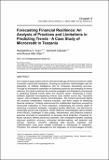| dc.description.abstract | This research paper delves into the intricate landscape of financial resilience within
Tanzanian microcredit institutions, focusing on predictive methodologies and the
integration of Artificial Intelligence (AI) for enhanced forecasting accuracy.
Through an exhaustive exploration of traditional practices and emerging AI-driven
solutions, this study examines the evolving strategies and limitations encounteredpredictive capacities within Tanzanian microcredit institutions. It emphasizes the
imperative nature of investing in resources and expertise to leverage AI potential
for sustainable growth and heightened forecasting accuracy in this rapidly evolving
financial landscape. This study contributes essential insights into the challenges,
opportunities, and potential pathways for leveraging advanced technologies in
enhancing financial resilience within microcredit institutions, fostering a more
sustainable and prosperous future for Tanzania microcredit sector.
in predicting financial trends within this dynamic sector. Employing a mixed-
methods approach encompassing diverse case studies across key Tanzanian
regions - Dar-es-Salaam, Arusha, and Kilimanjaro - the research garnered insights
into localized complexities, historical evolution, and direct impact on bolstering
financial resilience. Findings underscored the multifaceted objectives pursued by
microcredit institutions in trend projection, emphasizing the primary goals of
optimizing investment strategies, managing liquidity effectively, and planning for
sustainable growth and expansion. While traditional methodologies demonstrated
some efficacy, challenges in data quality, interpretation, and predictive analytics
expertise emerged as impediments to accurate trend projection. Proposed AI-
based solutions offered promising outcomes, with anticipated benefits including
improved prediction accuracy, enhanced decision-making, and potential cost
savings. However, concerns regarding data security, expertise, and
implementation costs pose notable challenges to widespread AI integration.
Therefore, the research advocates for the integration of AI technologies to fortify | en_US |

